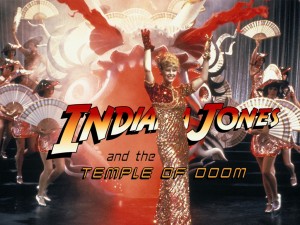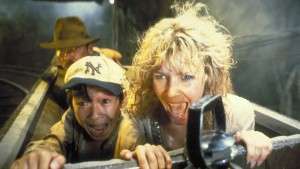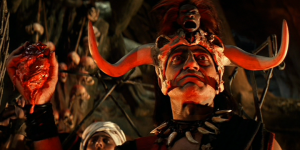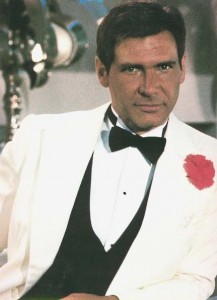100 Film Favorites – #75: Indiana Jones and the Temple of Doom
(Steven Spielberg, 1984)
 25 entries down! We’re now officially one quarter of the way through the Countdown.
25 entries down! We’re now officially one quarter of the way through the Countdown.
We kick off the second quarter with the film that inspired the PG-13 rating.
Temple of Doom is the second Indiana Jones film, released three years after the success of Raiders of the Lost Ark in 1981. However, Temple of Doom is actually a prequel to the earlier film, not a sequel (Raiders is set in 1936, Temple in ’35). But since plans to feature elements such as Abner Ravenwood (Indy’s old professor and the father of Marion Ravenwood) and rival archaeologist Rene Belloq (whose head explodes at the end of Raiders) were later dropped, the film could just as easily be seen as a sequel. Making it a prequel just makes Marcus Brody, who in Raiders cautions Indy not to take the Ark of the Covenant lightly, warning “It’s like nothing you’ve ever gone after before,” seem awfully forgetful to overlook the incident with the supernatural demon cult just a year earlier.
Temple has Indiana Jones crash-landing in the Himalayas when he’s betrayed by an associate in the Chinese antiquities market. Indy, along with a nightclub singer and a small Chinese boy who happened to get caught up in Indy’s escape, make their way into an Indian village. The village elders tell Indy that their children have been taken by members of the brutal Thuggee cult, officially extinct since the 1800s, but now rumored to be making a resurgence. The Thuggee also stole a magical rock which is credited with bringing good fortune to the village. Indy and crew head to Pankot Palace, the seat of local government, to figure out what’s up. They break bread (and eels and monkey brains) with the young maharaja and his prime minister, who insist that the Thuggee no longer exist as an organization. But that night, Jones is attacked by an assassin, and begins to suspect something might be amiss. He and his companions discover a passageway into a secret temple (of DOOM!) conveniently located directly beneath the palace.
Inside the temple, Indy finds the Thuggee thriving. They have been successful in locating three magic rocks like the one missing from the village. Jones deduces that these must be three of the five Sankara Stones, artifacts from Hindu mythology which will grant their possessors vaguely-defined “fortune and glory.” The cultists are eagerly digging for the remaining two stones, using the enslaved children from surrounding villages as miners. Throw in brainwashing and the occasional human sacrifice, and the Thuggee start to seem like a pretty disagreeable bunch. Eventually, Indy, Willie (the nightclub singer), and Short Round (the Chinese boy) successfully defeat the cultists and overseers (with help from the soldiers of the British Raj), free the child slaves, and restore the Sankara stone to the village.
Temple of Doom has a markedly darker tone than Raiders of the Lost Ark. The film’s violence, and in particular the human sacrifice scene, in which a man’s beating heart is ripped from his chest and set on fire, is credited with prompting the MPAA to create the PG-13 rating (Temple of Doom was rated PG, the only thing higher at the time was R). George Lucas and Steven Spielberg have half-jokingly attributed this darkness to the bitter breakups they had both just gone through prior to making the film. But you have to question their judgement somewhat. Somewhere along the line they must have thought, “Wow, the first movie was beloved by people of all ages. I know just what we need in the sequel: Child slavery and graphic human sacrifice!” In fact, when approached with the subject matter, screenwriter Lawrence Kasdan (who wrote The Empire Strikes Back, Return of the Jedi, and Raiders) refused to be involved with the project: “I just thought it was horrible. It’s so mean. There’s nothing pleasant about it…the movie is very ugly and mean-spirited.” In addition, the film was heavily criticized by the Indian government, who protested the haphazard presentation of Hindu mythology (incorporating sacrifical practices of South American and Egyptian cultures) and cuisine (“chilled monkey brains” are not actually a staple of the Indian diet) as barbaric and racist.
This darker tone may have something to do with Temple of Doom ranking lower on the list than the other two Indiana Jones films (the fourth one doesn’t count). However, I don’t begrudge the filmmakers’ their choice. Indiana Jones is a globetrotting adventurer, so it would make sense that he’d experience different cultures and face foes other than the Nazis. Taking the second film in a different direction from the first allows us to see Indy in different parts of the world and even different social environs, as when he’s schmoozing in a white tuxedo in the opening nightclub scene.
What really places Temple below the other entries on this Countdown is the shallow nature of the characters. Among the “good guys,” Indy’s new traveling companions are mostly just obnoxious – Willie Scott is there mostly to scream, and Short Round is there mostly to inadvertently trigger booby traps. The main villains are introduced too late in the film, and are scarcely even referred to by name. This results in us caring less about the characters and their fates than we should, and, to me at least, makes Temple of Doom more boring than the other entries in the series.
Nevertheless, the film is an Indiana Jones movie. There’s great action, incredible visuals, and memorable dialogue. There’s mine-cart races, giant bats, booby traps, plane crashes, and even a Busby Berkeley-style musical number. And that’s fortunate and glorious enough for me.
Also, now I have a hankering for chilled monkey brains. If they’re not really served in India, anybody know where I CAN get some?
Tidbits: The three protagonists were named for the filmmaker’s dogs – Indiana for Lucas’, Willie for Spielberg’s, and Short Round for screenwriter Willard Huyck’s.
-Several of the film’s sequences actually originated in the first draft of the Raiders script. The mine-cart chase, Indy’s showdown with Chinese gangster Lao Che, the plane crash-turned-toboggan ride in the Himalayas, and even the final shot, with Indy pulling Willie in for a kiss with his whip, were all excised from early Raiders story meetings between Lucas, Spielberg, and Kasdan.
—
Brian Terrill is the host of television show Count Gauntly’s Horrors from the Public Domain. You can keep up with Brian’s 100 Film Favorites countdown here.











